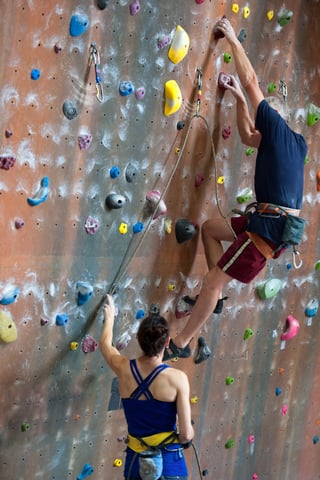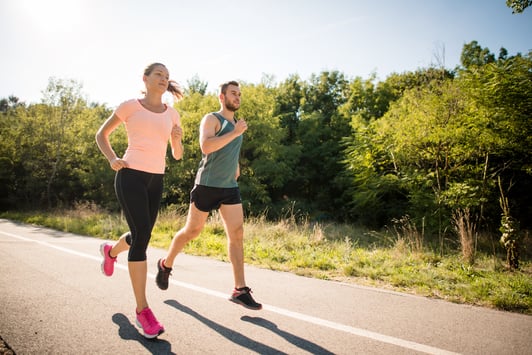 When people think of the word “healthy,” they typically have a vision or an expectation in their heads. We equate “healthy” with having the perfect body (which, by the way, means something different to everyone), making the perfect food choices, getting a certain amount of exercise each week, getting a certain amount of sleep each night, and having very little stress.
When people think of the word “healthy,” they typically have a vision or an expectation in their heads. We equate “healthy” with having the perfect body (which, by the way, means something different to everyone), making the perfect food choices, getting a certain amount of exercise each week, getting a certain amount of sleep each night, and having very little stress.
Everyone Makes Health and Wellness Mistakes
But this isn’t always reality. It’s not uncommon for people to begin making healthy lifestyle changes and developing healthy habits, only to give up once they realize how incredibly difficult it is to maintain "perfect" nutrition and exercise. In fact, I would argue that this level of perfectionism is impossible to achieve.
Your journey to health will not be perfect. And your efforts to maintain your health will not be perfect. We’re all imperfect. You won’t always make the healthiest food choices. You won’t always get 150 minutes of moderate to high-intensity exercise each week. You won’t always dedicate enough time to stretching, or practicing meditation on a regular basis. Wouldn’t it be a dream if we could all get eight hours of sleep every night? And we all have different body types; we come in all different shapes and sizes.
What Does It Mean to Be “Healthy”?
Everyone has expectations, and being a fitness coach and personal trainer for the last 15 years, I’m no exception to this rule. Even I have struggled with finding my healthy. So what does healthy mean? What does healthy look like
Merriam-Webster’s dictionary defines healthy as
“The condition of being sound in mind, body, or spirit; a condition in which someone or something is thriving or doing well.”
The World Health Organization defines healthy as
“A state of complete physical, mental, and social well-being and not merely the absence of disease or infirmity.”
What’s truly important when becoming healthy is how you feel mentally and physically. Healthy people tend to have more energy; feel well rested, have fewer aches, pains, and illnesses; and just generally feel good about themselves. And that right there is, by definition, healthy. Healthy really doesn’t mean you always make perfect choices or have the “perfect” body; it means you feel well.
My healthy means I occasionally eat chicken nuggets with my kids for dinner so we have time to go outside to play basketball before it gets dark. My healthy is going to bed at 9:30pm and waking up at 5:30am to get some work done, so once my kids go to school I can work out. My healthy means I have wrinkly, stretched out skin on my belly from having two kids, but I’m at a weight where I feel great. I’m not perfect, but once I stopped trying to be perfect, and just was healthy, it made life and achieving mental and physical health so much easier.
At the end of the day, being healthy is not about fitting into a certain mold. It’s not about following the latest diet or exercise trends. It’s about finding your definition of healthy that allows you to thrive physically, mentally, and spiritually. Practice healthy eating as often as possible, get exercise whenever you can, go to bed when you’re tired, and try not to compare yourself to other people’s definition of health. Remember, each individual is different and healthy looks different to everyone. Focus on feeling well!


 Walk the airport instead of sitting and waiting for your flight. Get your vacation started off on the right foot and finish on a good note. There are endless opportunities to get in your daily dose of steps at the airport. Just be sure to keep correct posture as you move, especially if you are carrying or dragging a bag.
Walk the airport instead of sitting and waiting for your flight. Get your vacation started off on the right foot and finish on a good note. There are endless opportunities to get in your daily dose of steps at the airport. Just be sure to keep correct posture as you move, especially if you are carrying or dragging a bag.
 Someone recently asked me, “What is your favorite workout?” I thought about my answer for a little bit. I do like to run, and I usually run about three days a week, but is that my favorite workout? No, my favorite workout is always when I’m trying new exercises or activities!
Someone recently asked me, “What is your favorite workout?” I thought about my answer for a little bit. I do like to run, and I usually run about three days a week, but is that my favorite workout? No, my favorite workout is always when I’m trying new exercises or activities!
 It seems that running injuries are all too common. There have been many research studies done on runners and, each year, as many as 79% of runners are sidelined due to injuries. Here are 5 ways to avoid injuries when running.
It seems that running injuries are all too common. There have been many research studies done on runners and, each year, as many as 79% of runners are sidelined due to injuries. Here are 5 ways to avoid injuries when running. 
 Are you looking for fitness tips, a little extra motivation or some exercise accountability? There’s an app for that! Over the past few years, health and fitness apps have grown and can provide information such as, distance and pace, strength, circuit and flexibility routines, estimate calorie expenditure, and some can measure your heart rate. Some apps will send daily fitness tips or motivational statements to help keep you on track with your exercise routine. But, if you’ve ever tried to search for health and fitness apps on your phone, you know how overwhelming it can be.
Are you looking for fitness tips, a little extra motivation or some exercise accountability? There’s an app for that! Over the past few years, health and fitness apps have grown and can provide information such as, distance and pace, strength, circuit and flexibility routines, estimate calorie expenditure, and some can measure your heart rate. Some apps will send daily fitness tips or motivational statements to help keep you on track with your exercise routine. But, if you’ve ever tried to search for health and fitness apps on your phone, you know how overwhelming it can be.